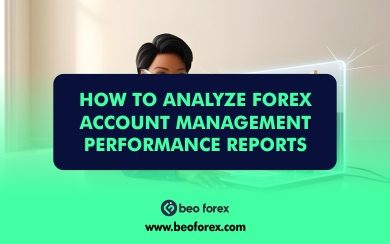How to analyze Forex account management performance reports is crucial for any investor who wants to ensure their account is being managed effectively. These reports give one good insight into the trading strategies adopted by the account manager, general performance, and risk management. Investors can evaluate whether their goals have been achieved by grasping significant metrics such as profit and loss, risk exposure, and trade history. However, the forex account management performance reports can be tricky to interpret if not well understood, and having results for only the short term can be misleading. A balanced approach in the analysis will reveal strengths and areas of risk. This article will further explain how to analyze forex account management performance reports and how it will help your trading journey.
Understanding Forex Account Management
Forex account management involves professional handling of an investor’s forex trades by individual managers or reputable firms. This service enables clients to earn returns with minimal personal involvement in monitoring their investments. The account manager executes trades, manages risk, and develops tailored strategies to align with the client’s financial goals.
Role of an Account Manager
In Forex account management, the role of an account manager is very important and holds the responsibility for the following:
- Formulate Trading Strategy: It will develop a customized trading strategy based on market analysis, the client’s overall goals, and risk tolerance.
- Trade Execution: Making wise decisions to buy and sell on behalf of the clients through the exploitation of market opportunities.
- Risk Management: Identifying the potential risk and strategies to be implemented for safeguarding the investments made by the clients.
- Monitoring Performance: Keeping a close eye on account performance and market trends, adjusting strategies to maximize returns accordingly.
- Communication with Client: The account manager regularly informs the clients about their account performance, market developments, and any change in strategy, besides maintaining transparency and gaining their trust.
Key Components of Performance Reports
Profit and Loss Statement
This is the basic content of performance reports, which details the financial outcome of trading activities. It hints at the amount of money made or lost within a certain time frame and reflects the overall performance. Investors shall identify how well their trading strategies are working through the understanding of P&L and, therefore, be in a position to make prudent investment decisions on future investments.
Risk Metrics
Risk metrics are the main indicators of the level of risk in trading activities. Examples are drawdown, which is the peak-to-trough decline in account value, and volatility, which refers to the measuring degree of variation of a time series of price. Investors monitor these risk metrics to have an idea about any possible losses and whether the risk taken is within the limits of their investment objectives.
Trade History
The section on trade history describes all trades executed during a certain time, involving entry and exit points of the trade, size of the trade, and what happened as a result of each trade. In an overall view, Trade History review becomes very important to understand the pattern of trading behavior, which keeps working or which needs improvement.
Benchmark Comparison
Benchmark comparison is defined as the performance of the account measured against relevant industry benchmarks or indices. The comparison shall further enable the investor to establish whether the account manager is able or unable to generate returns satisfactory against the general market or other similar trading strategies. Understanding these benchmarks will provide a context to the performance results and give a guide towards future investment decisions.
Performance Analysis Techniques
Return on investment, drawdown, risk-adjusted returns, and even the consistency of performance are some of the key performance metrics that one may apply in judging Forex managed accounts. ROI simply denotes profit over some period in time, while drawdown refers to the peak-to-trough fall of an account’s value. Risk-adjusted return should also account for the amount of risk taken toward the attainment of a certain return. This will provide a holistic view of the performance. The performance consistency shows the generation of returns by the managed account over time.
Return on Investment
Forex managed accounts are usually presumed to generate positive returns to investors through trading of currencies in the foreign exchange market. Their ROI may show great fluctuation depending on the strategy employed by the money manager, along with prevailing market conditions. Historically, Forex trading has given the opportunity to gain high returns but in itself carries the risks due to volatility in the currency markets. Thereby, investors should judge the historical ROI of managed accounts with consideration of their risk tolerance before investment.
Drawdown
Drawdown is a very important measure that can be utilized to approximate the risk for any Forex managed account. It is the degree of an account’s value depression from its peak. High drawdowns indicate potential heavy losses that can deplete investor capital and harm long-term performance. Money managers can mitigate drawdowns through effective risk management practices to protect investors’ funds during unfavorable market conditions.
Risk Adjusted
Risk-adjusted returns refer to an evaluation of a Forex-managed account based on the amount of risk taken for achieving a particular level of return. The Sharpe and Sortino ratios will be the metrics again helpful to the investors to present an appraisal of the risk-adjusted performance. A larger Sharpe or Sortino ratio implies better risk-adjusted returns. Consequently, this means a greater number of profits against the level of accepted risk. The investor shall look out for an account that has appealing risk-adjusted returns to ensure better investment returns.
Consistency of Performance
Consistency of performance is crucial for investors seeking steady and predictable returns from forex managed accounts. A reliable track record indicates that a money manager can generate profits regardless of market conditions. Therefore, investors should review historical performance data to assess the dependability of a managed account and ensure it aligns with their investment goals and time frame.
Frequently Asked Questions (FAQs)
What am I to look at when analyzing a Forex account management performance report?
- In case you actually go over a performance report, be sure to pay much attention to the profit and loss summary, showing total gains and losses, besides considering such risk metrics as drawdown and volatility for an idea about the risks involved. Analyze the trade history for information on executed trades, including entry and exit points. Look for benchmark comparisons that explain how the account performance measures up against relevant indices. Finally, check the KPIs: return on investment (ROI) and average profit per trade-formulate a wholesome view about trading success there.
How will I know if a Forex account manager is performing well or not?
- Indications of a good account manager may include regular net gains, low drawdown figures to show some positive risk management, and numbers that outperform their benchmarks. A good account manager will also make sure reports are transparent: performance clear and strategizing open for discussion.
What is considered an acceptable drawdown in Forex trading?
- Tolerable levels of drawdowns differ, with strategies and personal risk appetites also differing. Generally speaking, low-risk strategies will aim for less than 5-10% drawdowns, while medium-risk can accommodate around 10-20%. High-risk strategies can tolerate more than 20% drawdowns, but these should be coupled with very sound risk management in order to reduce potential losses.
How often should I review performance reports?
- The frequency will be influenced by personal preference and investment strategy. It may be necessary to have monthly reviews for ongoing assessment in order to make timely adjustments. Quarterly reviews will show longer performance trends, while an annual review provides an overall performance and strategy effectiveness assessment in its entirety.
























